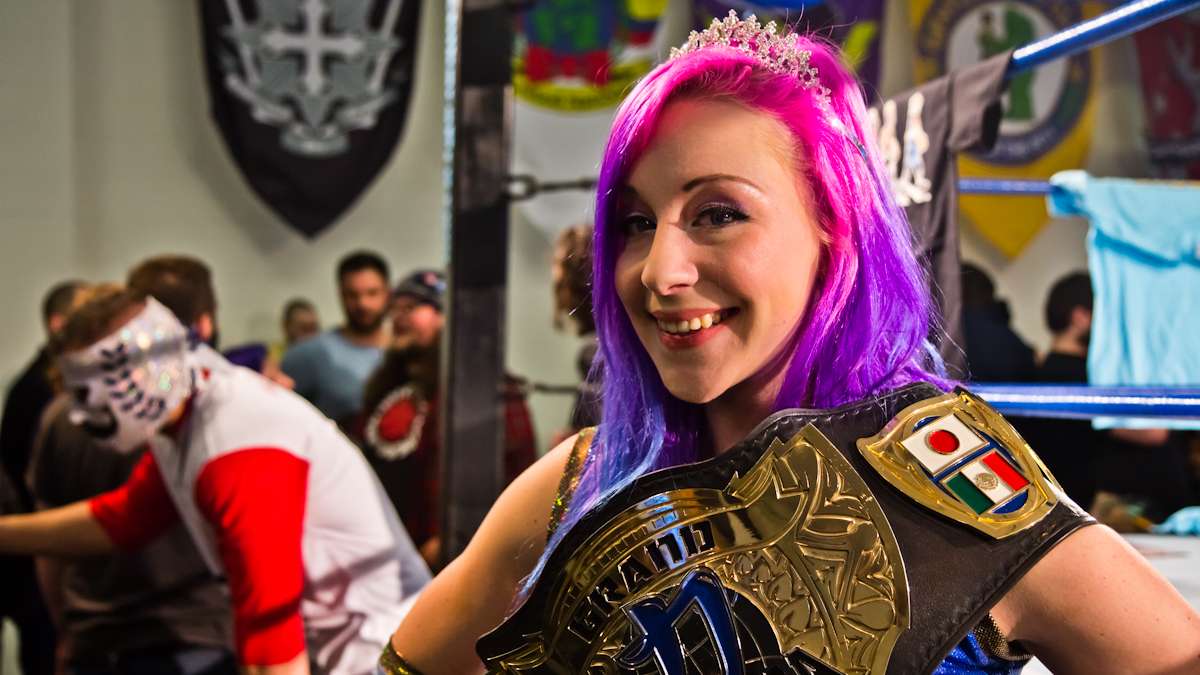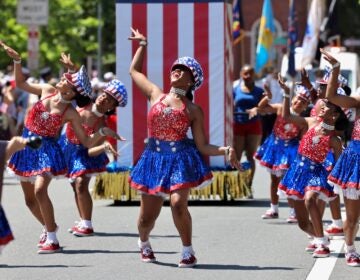On the road to Wrestlemania or maybe just living a childhood dream [photos + video]
ListenMillions of pro wrestling fans will be looking to Arlington, Texas this weekend as it hosts Wrestlemania 32. This year’s event is set to break attendance records and will feature some of the biggest names in the business, including Triple H, Brock Lesnar, Roman Reigns and The Undertaker.
Long before someone is able to leap off the top turnbuckle into the spotlight of professional wrestling’s premiere event they need to master the fundamentals of this unique mashup of athleticism and acting.
Recently, a group of would-be grapplers attended an introduction to pro wrestling workshop at the Wrestle Factory — a former Philadelphia warehouse that has been converted into a professional wrestling training facility. The free class is offered a few times each year. It’s designed to expose prospective trainees to the fundamentals of entertainment based physical combat before they commit to formalized training.
The class was made up of men and women ranging, some as young as 18, others in their late 20’s. Just like mainstream sports, participants warmed up with some stretching and light calisthenics before moving into more rigorous exercises.
“Lightning” Mike Quakenbush and Tom “Reckless Youth” Carter founded the Wrestle Factory in 2002. Quakenbush is also the head trainer. His former student Drew Gulak has wrestled all over the world. Now, he is as an instructor at the Wrestle Factory. Together, Quakenbush and Gulak showed students how to perform a collar-and-elbow lock up, generally the first thing the audience sees in a match.
Quakenbush and Gulak emphasized the importance of exaggerated moves as the students grabbed each other by placing their right hand on the back of their opponents neck and their left hand at the pit of their opponents elbow.
“This is physical theater, is what were making,” said Quakenbush. “So I need to make sure the people that are 90 rows back can tell what is going on as clearly as the people in the front row. So we need gigantic movements, so you must blow up your movements and make them bigger.”
Ian Fried was one of a dozen novices in the class. A 27-year-old New York City government employee, Fried said he’s dreamed of stepping into a professional wrestling ring ever since he was a boy.
“I went to school. I got a real job. I work a real job now,” he said. “I took the day off today, drove down from New York to be here just to finally give that pipe dream a chance at becoming a reality.”
Breaking into pro wrestling isn’t what it was 20 years ago when Mike Quakenbush got his start. The business is more exposed — it had to admit to being entertainment to avoid being regulated the way pro sports such as baseball or hockey are. And it has undergone a globalization of styles and techniques. He takes these factors into consideration when developing the school’s curriculum.
“What is relative to modern day audiences?” asked Quakenbush. “What do they want to see put on stage and what will they think is worthy of their consumer dollars in this day and age preoccupies every decision we make in the way that we train people at the Wrestle Factory.”
Before becoming a wrestler, Quakenbush studied journalism at the University of Pittsburgh, so he understands the importance of good storytelling. He draws inspiration from books, graphic novels and TV shows to develop his stories and characters. He will only assign a wrestling persona to people when they can consistently demonstrate mastery of the physical techniques. As far as characters go, Quakenbush said he likes to cast people into roles they never imagined playing.
“I’m going to give you something to which you assign no ego,” Quakenbush said, “and now freed of that, freed of making the performance slave to the wants and need of your heart, what can you bring to the stage?”
Drew Gulak said about 10 percent of people who attend the entry-level workshop end up continuing to take classes. He admitted even those who graduate can struggle to make a living inside the “squared circle.”
“There are many many places for you to work as an independent wrestler today,” he said. “There’s not a lot of money to be made in it because of that because there’s so many and there’s also a shortage of experienced places for you to go and really gain true knowledge as opposed to just figuring it out on your own.”
Quakenbush was quick to point out that there are hundreds of wrestling schools, but graduates of the Wrestle Factory have the opportunity to perform in front of paying audiences under the Chikara banner, a family-friendly wrestling promotion owned by Quakenbush that has put on shows across the United States, Canada, Europe and Japan.
“The people that finish our program, you see them in our ring, you see them on our events, and they go on tour with us. They are the same people you’ll see when we go to Chicago, when we go to New York, later this year when we tour Europe,” said Quakenbush.
A lifelong fan, Ian Fried said he was grateful for the opportunity to see a wrestling ring from the other side of the ropes. He said he isn’t sure if he’ll be pursuing wrestling full-time but he’s not ruling out more classes.
“Whether this is the only time in my life I’ll get to do it or whether I’m going to do it for a career for years down the road this was the experience of a lifetime,” said Fried.
WHYY is your source for fact-based, in-depth journalism and information. As a nonprofit organization, we rely on financial support from readers like you. Please give today.















